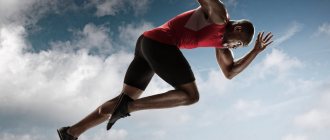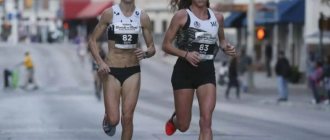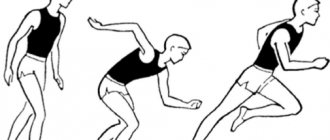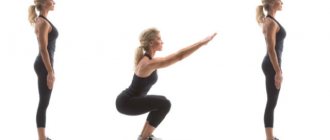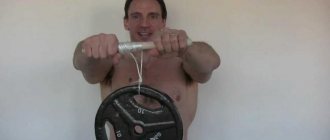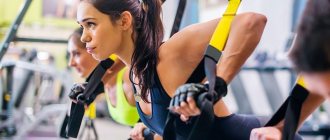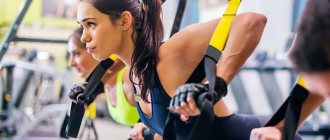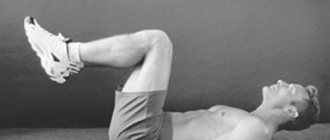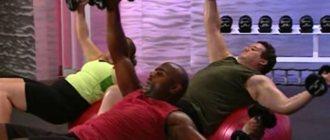In Ancient Greece there was a saying: “if you want to be healthy, run, if you want to be strong, run, if you want to be beautiful, run.”
Running is a simple physical exercise that uses various muscles of the human body, puts the necessary stress on the joints, stimulates blood circulation, and allows the body's tissues to receive the necessary oxygen in sufficient quantities to continue life.
Running helps begin the process of cleansing the body, removing harmful toxins that leave the body through sweat. This physical exercise allows you to develop endurance, strength, speed and increase the overall tone of the body.
Let's start with a warm-up
Warm-up prepares the body for upcoming loads, ensuring normal functioning of joints and ligaments . It helps reduce the risk of injury and improve performance.
Important! A proper warm-up reduces the risk of injury by 45%.
Warming up increases your overall body temperature and warms up your muscles. At the same time, metabolism accelerates, the heart is activated and the respiratory system is activated, and muscle performance increases.
Warm-up should last on average 10-15 minutes . To engage the joints, leisurely, circular movements are shown for the muscles of the arms, torso, legs, jumping rope, rotation of the joints of the limbs and spine to increase flexibility. Squats and jogging are ideal warm-ups.
Increased Strength
Building muscle will increase your speed and bring other health benefits. You don't even have to go to the gym, just do the following exercises after your run:
- 10-15 push-ups
- 10 lunges forward and sideways
- 10 single leg squats on each leg
- 1 minute plank.
These basic exercises will help you strengthen the muscles that keep your body strong and stable.
Doing strength training after your running workout will help ensure you are fully rested on your recovery days.
How to start (tactics)
Running 1 km is considered not an easy distance - endurance and speed training are required for good results. In addition, the distance is fleeting.
A smart tactic would be to concentrate on cross-country training. Persistent tempo cross-countries will increase endurance, that is, you need not just run 5, 7 or 10 km in 1 workout, but accelerate in segments of 300-500 m along the distance. There should be at least 5-7 of them. In this case, the heart gets used to working at the limit of its strength. In competitions, this tactic will help you speed up at the finish line.
1 or 2 km are considered medium distances and here you need to correctly distribute your forces . You need to remember in which phases of running it is better to speed up and when to slow down. You need to pick up the pace at the beginning and at the very end. For the first 6 - 8 seconds, run at 80 - 90% of maximum speed. Then slow down and maintain the same pace as you ran for 1 km. Accelerate again almost before the finish, about 200 meters away.
During training, implement 10 - 12 200m sprint segments at a good competition pace. As you run, imagine that you are finishing. This will help increase speed.
Increased stride speed
The speed at which your feet touch the ground is called stride speed or stride revolution. You should try taking faster and shorter steps, this will definitely increase your speed.
Most new runners have a running speed that is too slow. Trainers sometimes recommend taking 180 steps per minute. But still, some scientists believe that the speed of steps is a purely individual indicator.
You can determine your current speed and improve it with the following exercises:
- Determine your current performance. While running, count how many times your right foot touches the ground in 1 minute;
- Double this number to get your turnover rate;
- Try to improve it with a running exercise.
Run in 1-minute intervals, starting at your usual pace. Then run again, but increase the count of kicks. Repeat the sequence several times, each time trying to increase the number of kicks by one.
If you have a heart rate monitor, you can monitor your pulse. You perform your most effective steps at your lowest heart rate.
Follow the correct running technique. Your feet should be placed under your hips, not in front of your body, when running.
1 km run: technique and breathing
Running technique involves, first of all, correct foot placement. It can be set in 2 ways:
- By rolling the weight from heel to toe or placing emphasis on the toe and then on the foot. The vast majority prefer method 1. It is also suitable for beginners. This technique prevents the destruction of bones and joints and reduces the risk of injury.
- Method 2 is not popular. Used in professional sports.
In addition to the feet, the running technique requires the correct position of the body: the back is flat and straight, the head looks at the horizon line.
A mistake would be to tilt your head forward and even sway it slightly from side to side.
The foot is placed exactly under the knee, otherwise it will get ahead of the center of gravity and the movement will slow down. It is better to land the foot on the part between the heel and the middle of the foot. Here are the nerve endings that give the muscles a signal to absorb shock. The knees should be slightly bent when transferring the center of gravity to them, this will absorb the shock.
Avoid jumping - this wastes energy - the foot touches the ground, begins to move smoothly back, then comes off again. This technique eliminates sprains and injuries to the calf muscles, knees and hips.
You should concentrate on breathing, do not talk, so that the pace of breathing and running coincides. Inhalations and exhalations are short and jerky, breathing from the stomach, not from the diaphragm. Inhale through the nose, exhale through the mouth. Exhale slightly shorter than inhale. Using this technique ensures breathing stability after signals arrive to the brain. If such signals are not received, the body quickly directs all its efforts to stop running in order to even out breathing.
Hand and body work
The back should be straight, the shoulders should be straightened, you should not hunch or slouch while running. This will help straighten the chest and allow maximum inhalation.
While running, you need to relax your legs and move them smoothly. The normal rate is 3 steps per second. In this case , the legs are slightly bent at the knees so that there is no pinching in the joint .
The arms should be bent at the elbows at a right angle and pressed to the body. There should be no tension in your elbows.
According to your personal feelings, your palms can be loosely clenched into fists (so that a tennis ball can fit inside your palm), or relaxed.
Important! When running, do not lift your legs high, do not sway from side to side, do not swing your arms too much or bend over.
Accompanying factors
In addition to basic training, the effectiveness of running depends on a number of accompanying factors:
- Warm up . Detailed development of joints, tendons and muscles will prevent injury under sudden load. High-quality warming up helps to increase strength indicators, because the body enters the physical activity mode. Warm-up can begin with circular movements of various parts of the body to develop joints and continue with a circle of light strength exercises (squats, push-ups) or a preliminary short run to warm up.
- Stretching . Developing flexibility helps increase strength and also improves internal biochemical metabolism in muscle tissue, which improves endurance. Stretching exercises should complete training complexes for the restoration of muscle tissue and high-quality cell function.
- Breathing . Deep, even breathing will ensure a productive run. It is the disruption of breathing that disrupts proper oxygen metabolism in the body and impairs endurance. Failure of endurance leads to rapid fatigue, increased cranial pressure, lightheadedness, and pain. As a result, the athlete is forced to take breaks and regain strength.
- General development of general physical fitness . To maintain high performance, it is useful to do general body conditioning separately from running exercises. Several classes on building strength and endurance in the form of separate workouts will be useful.
All of the listed nuances directly affect the quality of running; they are useful to develop for overall development and rapid progress in physical activity.
Let's start training
They start with a slow, leisurely long distance run. 2-3 km in a mode that is moderate for you, but you can’t start walking. You can only slow down your running pace. When you learn to run non-stop with calm breathing and without overwork, stage 2 of the plan will begin.
The next point is interval running, you need to learn how to run short distances in a minimum amount of time . For example, run at maximum speed for 100 m, then switch to a calm walk at 100 m. And so there are several approaches.
Alternatively, you can increase the segments and run them for a time at a running speed of 1 km: 100, 200, 300, etc. meters.
Increased endurance can be achieved by running in different modes over long distances: 400 m running at a calm pace, then 100 m at maximum speed; then just walk 50-100 meters to regain your breathing.
The third stage is repeating approaches with a gradual increase in speed and a decrease in rest time. This method of training is called fartlek. This type of training is unacceptable for daily use.
World records
The 1000 m race is not regulated at the Olympic Games, World and European Championships, therefore, not many records have been recorded. Experts say that if such a race were included in world competitions, it is highly likely that the record holder would be David Rudish, who showed the best result at a distance of 800 meters - 1:40.91.
Men
| Record set | Record holder | A country | Place | date |
| 2:11.96 | Noah Ngeni | Kenya | Rieti | 05 September 1999 |
Women
| Record set | Record holder | A country | Place | date |
| 2:28.98 | Svetlana Masterkova | Russia | Brussels | August 23, 1996 |
Athletes who set a world record must defend it, according to IAAF rules:
- Each athlete, after setting a world record, must undergo doping control by the IAAF committee.
- The race must take place with the participation of two athletes.
- The markings on the race course must comply with IAAF criteria.
- The race must consist of same-sex athletes.
- IAAF rules prohibit saving energy by using the pacemaker by hiding behind him in order to reduce wind resistance.
The final stage of training
After 2-3 weeks, when your physical fitness increases, try to pass an exam for yourself.
2 weeks before the test you need to run at speed . Such a plan will help identify shortcomings and show how to distribute forces during the race.
At the beginning of the distance, the acceleration should be maximum for the first 50-70 m, then you can slow down the running to your normal speed. This will help you meet the deadline without running out of energy.
200-250 meters before the finish, the running pace increases. And at the finish line, at 50-60 meters, put all your strength into maximum speed. Then you can rest and just warm up slightly.
The last week before the test is allotted for rest:
- 6 days before the start - you need to run 5-7 segments of 100 m at the stadium at an expected speed of 1 km;
- 5 days - run an easy cross-country 3-5 km;
- 4 days before the start - only warm-up;
- 3 days before the start - run 4-5 times 60 m at a speed slightly faster than it would be for 1 km;
- 2 days before the start - run 1-2 times 100 m at a kilometer speed;
- The day before the start - only a light warm-up.
Climbing stairs
If you don't have access to the mountains, use the stairs. Use the same approach as in the mountains.
- Find a multi-flight staircase
- Climb the stairs in 30 seconds, then go down to recover
- Repeat 5 times
- Gradually work your way up to 10 repetitions.
As your fitness level increases, try to run more stairs.
Advice from experts
Professionals advise the following:
- Don't forget about warming up.
- Don’t rush forward, stay behind - this will make running easier and easier psychologically.
- 2 hours before the start of the race, eat carbohydrate food, but not later - the food must be digested.
- When running in cold weather, lubricate the leg muscles with warming ointment.
- Frequent mistakes made by athletes include incorrect alignment of forces, running stride, amount of water in the body, clothing, schedule. All this reduces the results.
The above tips will help you understand the basic principles of preparing for a race and correct possible mistakes. The main thing, of course, in any endeavor is the desire and desire for accomplishment.
Development of time indicators
A kilometer is not a serious distance: you can run that amount in 3-4 workouts from zero level of physical fitness. Practical running time depends on your mental state, current strength levels and breathing. A standard jog at an extremely relaxed pace can take up to 5 minutes. Reducing the time to 3-4 minutes is a standard student criterion for an A. You need to develop the skill step by step, but there is nothing particularly difficult about it.
The natural 1 km running technique is based on gradual acceleration: at first, run at a moderate speed slightly above average, with a sharp acceleration at the end. This approach will help you maintain your strength towards the end of the race. A sharp start can make you run out of steam after 200-300 m, leaving little strength and breathing resources to successfully complete the distance.
